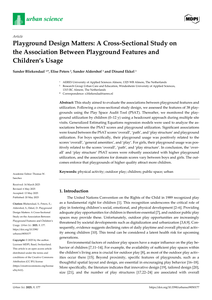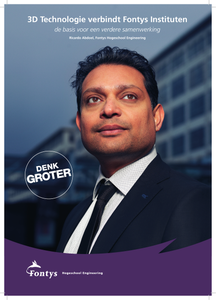This study aimed to evaluate the associations between playground features andutilization. Researchers assessed the features of 38 playgrounds using the Play Space Audit Tool (PSAT). They monitored how children (0–12 y) used the playground. The associations between the PSAT scores and playground utilization were analysed. Significant associations were found between the PSAT scores ‘overall’, ‘path’, and ‘play structure’ and playground utilization. For boys specifically, their playground usage was positively related to the scores ‘overall’, ‘general amenities’, and ‘play’. For girls, their playground usage was positively related to the scores ‘overall’, ‘path’, and ‘play structure’. In conclusion, the ‘overall’ and ‘play structure’ PSAT scores were robustly associated with higher playground utilization, and the associations for domain scores vary between boys and girls. The outcomes enforce that playgrounds of higher quality attract more children. Keywords: physical activity; outdoor play; children; public space; urban
DOCUMENT

Professional playground werpt een blik in de keuken van verschillende spelers in de game-industrie. Verschillende professionals uit deze industrie zijn aan het woord, waardoor een beeld ontstaat van het krachtenveld waar zij mee te maken hebben. Welke kennis van theorieën, concepten, procedures en processen zijn er nodig om het werk in de dagelijkse praktijk goed te kunnen doen?
DOCUMENT
The (pre)school environment is an important setting to improve children’s health. Especially, the (pre)school playground provides a major opportunity to intervene. This review presents an overview of the existing evidence on the value of both school and preschool playgrounds on children’s health in terms of physical activity, cognitive and social outcomes. In addition, we aimed to identify which playground characteristics are the strongest correlates of beneficial effects and for which subgroups of children effects are most distinct. In total, 13 experimental and 17 observational studies have been summarized of which 10 (77%) and 16 (94%) demonstrated moderate to high methodological quality, respectively. Nearly all experimental studies (n = 11) evaluated intervention effects on time spent in different levels of physical activity during recess. Research on the effects of (pre)school playgrounds on cognitive and social outcomes is scarce (n = 2). The experimental studies generated moderate evidence for an effect of the provision of play equipment, inconclusive evidence for an effect of the use of playground markings, allocating play space and for multi-component interventions, and no evidence for an effect of decreasing playground density, the promotion of physical activity by staff and increasing recess duration on children’s health. In line with this, observational studies showed positive associations between play equipment and children’s physical activity level. In contrast to experimental studies, significant associations were also found between children’s physical activity and a decreased playground density and increased recess duration. To confirm the findings of this review, researchers are advised to conduct more experimental studies with a randomized controlled design and to incorporate the assessment of implementation strategies and process evaluations to reveal which intervention strategies and playground characteristics are most effective. https://doi.org/10.1186/1479-5868-11-59 This is an Open Access article distributed under the terms of the Creative Commons Attribution License (http://creativecommons.org/licenses/by/2.0), which permits unrestricted use, distribution, and reproduction in any medium, provided the original work is properly credited.
MULTIFILE

BackgroundThe relative number of children meeting the minimal required dose of daily physical activity remains execrably low. It has been estimated that in 2015 one out of five children will be overweight. Therefore, low levels of physical activity during early childhood may compromise the current and future health and well-being of the population, and promoting physical activity in younger children is a major public health priority. This study is to gain insight into effects of a Physical Education based playground program on the PA levels during recess in primary school children aged 6-12.Methods/designThe effectiveness of the intervention program will be evaluated using a prospective controlled trial design in which schools will be matched, with a follow-up of one school year. The research population will consist of 6-12 year old primary school children. The intervention program will be aimed at improving physical activity levels and will consist of a multi-component alteration of the schools' playground. In addition, playground usage will be increased through altered time management of recess times, as well as a modification of the Physical Education content.DiscussionThe effects of the intervention on physical activity levels during recess (primary outcome measure), overall daily physical activity and changes in physical fitness (secondary outcome measures) will be assessed. Results of this study could possibly lead to changes in the current playground system of primary schools and provide structured health promotion for future public health.Trial registrationNetherlands Trial Register (NTR): NTR2386
DOCUMENT

Natural playgrounds stimulate active play in children and, as such, support their healthy development. Therefore, the municipality of Almere (The Netherlands), aims to develop more natural playgrounds within its neighbourhoods and parks. However, insight into how children play in these playgrounds is lacking, which is needed for optimal playgrounds design and policy development. Therefore, this study aimed to map the usage of a typical natural playground in Almere.
LINK
Interventions to improve children’s physical activity in Early Childhood Education and Care (ECEC) settings are needed. This randomized controlled trial examines the effects of a preschool-based playground program for ECEC teachers in a deprived urban area. On intervention preschools, the PLAYgrounds for TODdlers program (PLAYTOD) was performed. It focused on teacher’s knowledge and skills in order to create a challenging outdoor environment in which young children (2.5 to 4 years old) are able to practice their motor skills. Observations were performed before and after the program with a modified version of the SOPLAY protocol. The activating role of teachers (score from 0 = inactive to 4 = participating), the number of different physical activities, and the quality of children’s physical activity on playgrounds were observed. The latter included the number of performed fundamental movement skills and the estimated physical activity intensity (score from 0 = sedentary to 3 = vigorous). Descriptive statistics and linear regression analyses were used to evaluate the effects of PLAYTOD. After the program, the activating role of teachers on intervention playgrounds improved. Moreover, the program and consecutively the changes made by teachers had a positive effect on the number of different activities and the quality of children’s physical activity. The results emphasize an important role for ECEC teachers in improving physical activity in young children.
DOCUMENT

This study aimed to evaluate the children's usage and their physical activity levels at playgrounds with (N = 4) and without (N = 4) organized sports activities, following a quasi-experimental study design. Direct observations were used to assess the playground usage and estimate the playground users' age category, sex, and physical activity intensity level. The results indicated that playgrounds with sports activities were associated with 53% more users at the time of the activities. However, this increase was only seen in boys. Furthermore, playgrounds with sport activities were not associated with different physical activity levels in children as compared to children on regular playgrounds.
DOCUMENT

Background: The relative number of children meeting the minimal required dose of daily physical activity remains execrably low. It has been estimated that in 2015 one out of five children will be overweight. Therefore, low levels of physical activity during early childhood may compromise the current and future health and well-being of the population, and promoting physical activity in younger children is a major public health priority. This study is to gain insight into effects of a Physical Education based playground program on the PA levels during recess in primary school children aged 6-12.Methods/design: The effectiveness of the intervention program will be evaluated using a prospective controlled trial design in which schools will be matched, with a follow-up of one school year. The research population will consist of 6-12 year old primary school children. The intervention program will be aimed at improving physical activity levels and will consist of a multi-component alteration of the schools’ playground. In addition, playground usage will be increased through altered time management of recess times, as well as a modification of the Physical Education content.Discussion: The effects of the intervention on physical activity levels during recess (primary outcome measure), overall daily physical activity and changes in physical fitness (secondary outcome measures) will be assessed. Results of this study could possibly lead to changes in the current playground system of primary schools and provide structured health promotion for future public health
MULTIFILE

De wereld verandert in een razend tempo. Technologische ontwikkelingen hebben een grote impact op mens en maatschappij. Het verandert niet alleen onze manier van werken maar ook onze manier van leven. Steeds meer disciplines hanteren technologie als basis om in een professionele omgeving het werk kwalitatief beter, sneller en effi ciënter uit te voeren. Digitalisering, globalisering en informatisering maakt het mogelijk om plaats- en tijdonafhankelijk te studeren en te werken. Fontys Hogescholen speelt hier op in door tal van initiatieven te ondersteunen die gericht zijn op het volgen van deze en opkomende trends rondom technologische ontwikkelingen en de impact voor het onderwijs. Met het Fontys Objexlab zetten we deze beweging door. Opkomende technologieën zoals 3D printing en Robotica maken we graag toegankelijk voor collega’s. Andere instituten kunnen hiervan gebruik maken zodat zij hun onderwijs nog aantrekkelijker en actueler kunnen maken. In het najaar van 2014 zijn we gestart met het samenbrengen van collega’s van verschillende instituten en opleidingen om enerzijds deze nieuwe technologieen te leren en te ervaren, om daarna een stap te maken in het initiëren van ideeën en plannen om met deze kennis en vaardigheden onderwijsvernieuwing gezamenlijk vorm- en inhoud te geven.
MULTIFILE

Objectives: Promoting unstructured outside play is a promising vehicle to increase children’s physical activity (PA). This study investigates if factors of the social environment moderate the relationship between the perceived physical environment and outside play. Study design: 1875 parents from the KOALA Birth Cohort Study reported on their child’s outside play around age five years, and 1516 parents around age seven years. Linear mixed model analyses were performed to evaluate (moderating) relationships among factors of the social environment (parenting influences and social capital), the perceived physical environment, and outside play at age five and seven. Season was entered as a random factor in these analyses. Results: Accessibility of PA facilities, positive parental attitude towards PA and social capital were associated with more outside play, while parental concern and restriction of screen time were related with less outside play. We found two significant interactions; both involving parent perceived responsibility towards child PA participation. Conclusion: Although we found a limited number of interactions, this study demonstrated that the impact of the perceived physical environment may differ across levels of parent responsibility.
MULTIFILE
